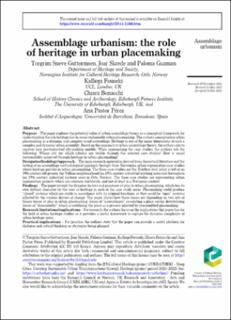Assemblage urbanism: the role of heritage in urban placemaking
Guttormsen, Torgrim Sneve; Skrede, Joar; Guzman, Paloma; Fouseki, Kalliopi; Bonacchi, Chiara; Péres, Ana Pastor
Peer reviewed, Journal article
Published version
Permanent lenke
https://hdl.handle.net/11250/3092668Utgivelsesdato
2023Metadata
Vis full innførselSamlinger
Originalversjon
10.1108/JCHMSD-12-2022-0208Sammendrag
Purpose – The paper explores the potential value of urban assemblage theory as a conceptual framework for understanding the role heritage has in social sustainable urban placemaking. The authors conceptualise urban placemaking as a dynamic and complex social assemblage. Heritage is one of the many dimensions of such a complex and dynamic urban assembly. Based on the approach to urban assemblage theory, the authors aim to uncover how postindustrial city-making unfolds. When approaching the case studies, the authors ask the following: Whose city for which citizens are visible through the selected case studies? How is social sustainability achieved through heritage in urban placemaking? Design/methodology/approach – The main research material is derived from theoretical literature and the testing of an assemblage methodological approach through three Norwegian urban regeneration case studies where heritage partake in urban placemaking. The three case studies are the Tukthus wall (what is left of an 19th century old prison), the Vulkan neighbourhood (an 19th century industrial working area) and Sørengkaia (an 19th century industrial harbour area) in Oslo, Norway. The three case studies are representing urban regeneration projects which are common worldwide, and not at least in a European context. Findings – The paper reveals the dynamic factors and processes at play in urban placemaking, which has its own distinct character by the uses of heritage in each of the case study areas. Placemaking could produce “closed” systems which are stable in accordance with its original functions, or they could be “open” systems affected by the various drivers of change. The paper shows how these forces are depending on two sets of binary forces at play in urban placemaking: forces of “assemblages” co-creating a place versus destabilising forces of “disassembly” which is redefining the place as a process affected by reassembled placemaking. Research limitations/implications – For research, the authors focus on the implications this paper has for the field of urban heritage studies as it provides a useful framework to capture the dynamic complexity of urban heritage areas. Practical implications – For practice, the authors state that the paper can provide a useful platform for dialogue and critical thinking on strategies being planned.

